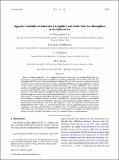| dc.contributor.author | Wei, Jun | |
| dc.contributor.author | Li, M. T. | |
| dc.contributor.author | Gordon, A. L. | |
| dc.contributor.author | Wang, D. X. | |
| dc.contributor.author | Rizzoli, Paola M | |
| dc.date.accessioned | 2017-05-01T15:56:31Z | |
| dc.date.available | 2017-05-01T15:56:31Z | |
| dc.date.issued | 2016-10 | |
| dc.date.submitted | 2016-06 | |
| dc.identifier.issn | 0022-3670 | |
| dc.identifier.issn | 1520-0485 | |
| dc.identifier.uri | http://hdl.handle.net/1721.1/108531 | |
| dc.description.abstract | Based on a high-resolution (0.1° × 0.1°) regional ocean model covering the entire northern Pacific, this study investigated the seasonal and interannual variability of the Indonesian Throughflow (ITF) and the South China Sea Throughflow (SCSTF) as well as their interactions in the Sulawesi Sea. The model efficiency in simulating the general circulations of the western Pacific boundary currents and the ITF/SCSTF through the major Indonesian seas/straits was first validated against the International Nusantara Stratification and Transport (INSTANT) data, the OFES reanalysis, and results from previous studies. The model simulations of 2004–12 were then analyzed, corresponding to the period of the INSTANT program. The results showed that, derived from the North Equatorial Current (NEC)–Mindanao Current (MC)–Kuroshio variability, the Luzon–Mindoro–Sibutu flow and the Mindanao–Sulawesi flow demonstrate opposite variability before flowing into the Sulawesi Sea. Although the total transport of the Mindanao–Sulawesi flow is much larger than that of the Luzon–Mindoro–Sibutu flow, their variability amplitudes are comparable but out of phase and therefore counteract each other in the Sulawesi Sea. Budget analysis of the two major inflows revealed that the Luzon–Mindoro–Sibutu flow is enhanced southward during winter months and El Niño years, when more Kuroshio water intrudes into the SCS. This flow brings more buoyant SCS water into the western Sulawesi Sea through the Sibutu Strait, building up a west-to-east pressure head anomaly against the Mindanao–Sulawesi inflow and therefore resulting in a reduced outflow into the Makassar Strait. The situation is reversed in the summer months and La Niña years, and this process is shown to be more crucially important to modulate the Makassar ITF’s interannual variability than the Luzon–Karimata flow that is primarily driven by seasonal monsoons. | en_US |
| dc.language.iso | en_US | |
| dc.publisher | American Meteorological Society | en_US |
| dc.relation.isversionof | http://dx.doi.org/10.1175/jpo-d-16-0132.1 | en_US |
| dc.rights | Article is made available in accordance with the publisher's policy and may be subject to US copyright law. Please refer to the publisher's site for terms of use. | en_US |
| dc.source | American Meteorological Society | en_US |
| dc.title | Opposite Variability of Indonesian Throughflow and South China Sea Throughflow in the Sulawesi Sea | en_US |
| dc.type | Article | en_US |
| dc.identifier.citation | Wei, Jun; Li, M. T.; Malanotte-Rizzoli, P.; Gordon, A. L. and Wang, D. X. "Opposite Variability of Indonesian Throughflow and South China Sea Throughflow in the Sulawesi Sea." Journal of Physical Oceanography 46 (October 2016): 3165. © 2016 American Meteorological Society | en_US |
| dc.contributor.department | Massachusetts Institute of Technology. Department of Earth, Atmospheric, and Planetary Sciences | en_US |
| dc.contributor.mitauthor | Rizzoli, Paola M | |
| dc.relation.journal | Journal of Physical Oceanography | en_US |
| dc.eprint.version | Final published version | en_US |
| dc.type.uri | http://purl.org/eprint/type/JournalArticle | en_US |
| eprint.status | http://purl.org/eprint/status/PeerReviewed | en_US |
| dspace.orderedauthors | Wei, Jun; Li, M. T.; Malanotte-Rizzoli, P.; Gordon, A. L.; Wang, D. X. | en_US |
| dspace.embargo.terms | N | en_US |
| dc.identifier.orcid | https://orcid.org/0000-0003-2431-6838 | |
| mit.license | PUBLISHER_POLICY | en_US |
| mit.metadata.status | Complete | |
